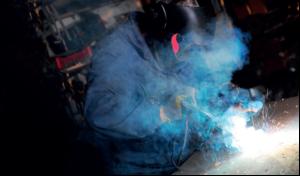Kevin Bristow explains how air cleaning performance
can help to minimise the major health and safety risks
posed by oil mist, fumes and smoke
The processes and operations
undertaken in industrial and
manufacturing enKevin Bristow explains how air cleaning performance
can help to minimise the major health and safety risks
posed by oil mist, fumes and smoke
The processes and operations
undertaken in industrial and
manufacturing environments
can emit dangerous levels of oil mist,
fume and smoke particulates. These
pollutants are a major health and safety
risk and can be severely damaging to the
wellbeing of employees, equipment and
products. Oil mist can be particularly
harmful. The fluids used to cool and
lubricate tools and stock in
metalworking processes are transformed
into a fine mist by mechanical force and
frictional heat. The mist can linger
causing health hazards, equipment
reliability issues and also contaminate
products.
Employees exposed to oil mist can suffer
respiratory problems and, depending on
the level of exposure, allergic reactions
and skin disorders. If it's not dealt with,
then oil mist will also eventually settle out
of the atmosphere, coating surfaces,
equipment and the building itself.
Therefore, removing oil mist from the air
is essential for workplace health and
safety, and to maintain a clean, efficient
operating environment.
The Health & Safety Executive brought
in the Control of Substances Hazardous to
Health Regulations in 2002 (COSHH)
which requires employers to control
substances that are harmful to employees'
health. These regulations require regular
monitoring to ensure employers are
taking the necessary action to control
hazardous substances.
Air filtration equipment
Using effective air filtration equipment
can help to ensure a high level of air
cleaning performance and will remove a
variety of oil mist, fumes and smoke from
the air. In Trion's opinion, an electronic air
cleaner will provide the most efficient
removal of oil mist, fumes and smoke.
Modern electronic air cleaners use
electrostatic precipitation (ESP)
technology which is suited to industrial
applications. At the heart of this approach
is a high efficiency collector cell.
Contaminated air is first drawn through
the unit's washable metal mesh pre-filter,
which traps larger airborne particles.
Remaining particles, some as small as 0.01
microns, then pass into a strong electrical
field within the air cleaner's ionising
section, where the particulate receives an
electrical charge. Charged particles then
pass into the collector plate cell, which is
made up of a series of equally spaced,
parallel plates. Each alternate plate is
charged with the same polarity as the
particles, which repel, while the
interleaving plates are grounded to attract
and collect the particulate.
A reduced dwell time requirement in
the electronic filtration unit translates to
an efficient performance - up to 95% submicron
particulate can be removed at an
air velocity of 3m/s. This performance, in
turn, will have an impact on the design,
sizing and energy efficiency of the entire
system. Less power is needed because
smaller extract fans can be used with
smaller motors. In fact, the typical power
consumption of an electronic air cleaner
of this type equates to 50 watts, which is
equivalent to a domestic light bulb. At the
same time, there will be fewer issues with
sound attenuation.
Maintenance can be an issue when it
comes to carbon filtration. However, an
ESP type air cleaner is designed to provide
optimum air cleaning efficiency whilst
requiring the minimum of maintenance.
Once the contaminated indoor air has
passed through the unit, clean air can be
re-circulated back into the workspace
rather than exhausted to outside, so
saving energy costs. The model choice of
ESP air cleaners, whether free hanging or
ducted, will depend on the size and
demand of individual applications, with
unit cleaning capacities ranging in air
volumes.
In many industrial environments there
is no way around creating oil mist, fumes
and smoke but protecting employees from
hazardous substances must be of
paramount consideration. Using effective
filtration will ensure particulates are
removed from the air efficiently and
quickly.
Kevin Bristow is sales director at Trion


